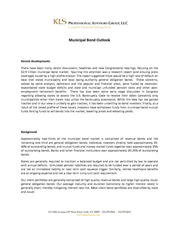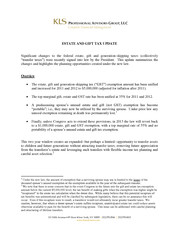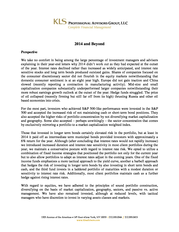Description
Our point of view
There is not an imminent widespread default risk. State and municipal governments need access to the
capital markets and any Congressional action that would create further credit uncertainty is remote
since it would impede such access. Such would result in severe budget cuts that would greatly and
negatively impact the overall economy. If, however, capital market access was destabilized, we believe
the integrity of the system would be protected even if Treasury or Federal Reserve action was required
as the consequences of systemic failure would be too severe.
This, however, is the “last resort” analysis. In the first instance, high quality revenue bonds are secured and collateralized by a pledged stream of revenues designed to cover debt service (interest and scheduled principal payments). In a Chapter 9 bankruptcy of a municipality these revenue bonds have special status and have a lien on these revenues. They are not compromised in a bankruptcy proceeding so long as the revenue stream remains. As for large issuer general obligation bonds, we expect that budgets balanced through spending and service reductions, increased tax rates and continuing economic recovery giving rise to tax revenue increases, coupled with changes in benefits and pensions going forward, should improve state finances. Nevertheless, we recognize that perceptions and fear can greatly impact markets in the short-term and result in reductions in bond values.
During the past two years we have, accordingly, diversified bond portfolios (geographically and by issuer), shortened maturities and increased credit scrutiny. While municipal bonds are not without risk, we continue to consider the particular portfolios of bonds held by our clients a risk mitigator in an investment portfolio that is well diversified by asset class and believe that they provide an appropriate after tax yield to full bracket taxpayers as compared to other fixed income investments. We will continue to monitor developments and keep you advised. February 11, 2011 -2- .
This, however, is the “last resort” analysis. In the first instance, high quality revenue bonds are secured and collateralized by a pledged stream of revenues designed to cover debt service (interest and scheduled principal payments). In a Chapter 9 bankruptcy of a municipality these revenue bonds have special status and have a lien on these revenues. They are not compromised in a bankruptcy proceeding so long as the revenue stream remains. As for large issuer general obligation bonds, we expect that budgets balanced through spending and service reductions, increased tax rates and continuing economic recovery giving rise to tax revenue increases, coupled with changes in benefits and pensions going forward, should improve state finances. Nevertheless, we recognize that perceptions and fear can greatly impact markets in the short-term and result in reductions in bond values.
During the past two years we have, accordingly, diversified bond portfolios (geographically and by issuer), shortened maturities and increased credit scrutiny. While municipal bonds are not without risk, we continue to consider the particular portfolios of bonds held by our clients a risk mitigator in an investment portfolio that is well diversified by asset class and believe that they provide an appropriate after tax yield to full bracket taxpayers as compared to other fixed income investments. We will continue to monitor developments and keep you advised. February 11, 2011 -2- .









